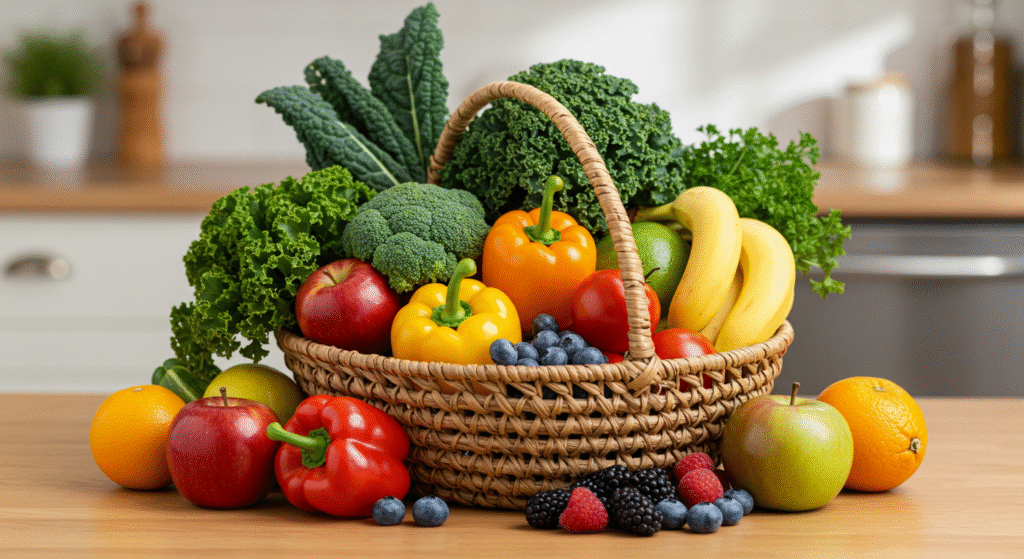Introduction: Why Balanced Diets Matter More Than Ever
If you’ve ever Googled “best diet plan” at midnight after a long day of scrolling TikTok while munching on chips—you’re not alone. The sea of diet advice is overwhelming: keto this, paleo that, low-carb, high-carb, intermittent fasting, “eat like a caveman,” or “eat like your grandma.” Confusing, isn’t it?
That’s exactly why “balanced diet” plans stand out. Unlike fad diets, they aren’t trying to trick your metabolism or cut out entire food groups. Instead, they focus on what your body actually needs: a practical, consistent way of eating that fuels energy, supports long-term health, and yes—still lets you enjoy life without fear of bread.
In this guide, we’ll break down exactly what balanced diets are, how to choose one that fits your lifestyle, examples of flexible plans you can actually live with, and practical steps to build meals that tick all the nutrition boxes. By the end, you’ll feel confident enough to create or adapt a balanced diet plan that’s realistic, sustainable, and enjoyable.
What Is a Balanced Diet Plan, and Why Does It Work?
At its heart, a balanced diet is about proportions, not restrictions. It includes the right mix of:
- Macronutrients (protein, carbs, fat)
- Micronutrients (vitamins, minerals, antioxidants)
- Hydration and fiber (often underrated heroes)
So while keto or juice cleanses obsess over cutting things out, a balanced diet focuses on balance: getting enough of everything your body needs without overdoing any one part.
Think of it like building a house:
- Protein is the bricks (muscle, tissue repair).
- Carbs are the electricity (energy).
- Healthy fats are insulation (hormones, brain function).
- Micronutrients are the nuts and bolts holding it all together.
Neglect one, and the house wobbles. Get them in the right balance, and you’ve got a strong, livable structure.
How Do You Build a Balanced Plate? (Step-by-Step)
Balanced diets can be simplified into something even kids in school cafeterias learn: The Plate Method.
Here’s the breakdown, recommended by health organizations like the WHO and USDA:
- Half your plate = Fruits & Vegetables
- Colorful, fiber-rich, nutrient-packed.
- Example: spinach, broccoli, carrots, blueberries.
- One-quarter = Whole Grains
- Choose complex carbs for steady energy.
- Example: brown rice, oats, quinoa, barley, whole-wheat pasta.
- One-quarter = Lean Protein
- Supports muscle growth and repair.
- Example: chicken, fish, tofu, beans, eggs.
- Healthy Fats on the Side
- Avocado, nuts, olive oil, seeds.
- Hydration
- Aim for water as your primary drink.
👉 Pro tip: Snap a quick photo of your dinner plate sometime—if it looks beige and monochrome, it’s time to add some colorful plants!
What Are the Best Balanced Diet Plans You Can Follow?
There isn’t a one-size-fits-all plan because people have different cultures, preferences, and lifestyles. But several diets are widely recognized as balanced and sustainable.
1. The Mediterranean Diet
- Core idea: Fresh fruits, vegetables, olive oil, legumes, fish, and moderate red wine.
- Why it’s balanced: It emphasizes heart-healthy fats, lean proteins, and tons of plants.
- Evidence: Linked to longevity and lower risk of chronic disease.
- Real-world example meal: Grilled salmon with quinoa salad, roasted veggies, and olive oil dressing.
2. The DASH Diet (Dietary Approaches to Stop Hypertension)
- Core idea: Focused on lowering blood pressure with whole foods, low sodium, high potassium.
- Why it’s balanced: Promotes fruits, vegetables, whole grains, and lean proteins, while limiting processed foods.
- Evidence: Clinically proven to reduce hypertension risks.
3. The Flexitarian Diet
- Core idea: Mostly plant-based, but allows animal products occasionally.
- Why it’s balanced: Encourages flexibility. You don’t need a “100% vegan or bust” mindset.
- Evidence: Improves heart health, reduces carbon footprint, and still lets you enjoy a slice of pizza or chicken wings.
4. The Traditional Balanced Diet (Varied, Moderated)
- Core idea: No strict rules—just the Plate Method and moderation.
- Why it’s balanced: Makes room for cultural foods, personal preferences, and lifestyle.
What Foods Should You Prioritize in a Balanced Diet?
Here’s your nutrition “shopping list” broken down by category:
Proteins (muscle & repair powerhouses)
- Poultry, fish, eggs, beans, legumes, tofu, tempeh.
Carbs (fuel for your brain & body)
- Whole grains, oats, quinoa, brown rice, sweet potatoes, fruits.
Fats (hormones & brain)
- Olive oil, avocados, almonds, walnuts, flaxseeds.
Micronutrient bombs
- Leafy greens, berries, cruciferous veggies, citrus fruits.
Hydration heroes
- Water, sparkling water, herbal teas, unsweetened coconut water.
What Mistakes Should You Avoid When Following a “Balanced” Diet?
- Cutting out fat completely (your body NEEDS healthy fats).
- Relying on processed “diet” foods (low-fat, low-carb packaged products often sneak in sugar and sodium).
- Ignoring portion sizes (three heaping spoons of peanut butter suddenly stop being “healthy fat”).
- Not planning meals (when hunger hits, drive-thru temptation rises).
- Forgetting enjoyment—overly rigid diets often backfire.
Balanced = not just nutrients, but also sanity.
How Do You Personalize a Balanced Diet Plan?
Everyone’s “best diet” is personalized. Use these steps to adapt:
- Identify your goal.
- Want weight loss? Focus on calorie balance + protein.
- Building muscle? Lean proteins + carbs for training.
- Health maintenance? Emphasize variety and balance.
- Consider your culture.
- Traditional cuisines (Indian dals, Mexican beans, Mediterranean olive oil, Japanese fish) can all form balanced diets.
- Check your lifestyle.
- Busy? Meal-prep helps.
- Traveler? Portable fruits, nuts, sandwiches are key.
- Listen to your body.
- Instead of demonizing foods, notice how different meals make you feel.
What’s a Sample 7-Day Balanced Diet Meal Plan?
Here’s a sample template you can adapt:
Day 1 Example:
- Breakfast: Oatmeal with banana, nuts, chia seeds.
- Lunch: Grilled chicken wrap with whole wheat tortilla + veggie salad.
- Snack: Greek yogurt with berries.
- Dinner: Baked salmon, quinoa, steamed broccoli.
(Repeat with variations of proteins, veggies, whole grains, and fruit. The idea is flexibility, not boredom!)
FAQs: Quick Answers to Common Balanced Diet Questions
1. What’s the difference between a balanced diet and a weight-loss diet?
A balanced diet isn’t always about restricting calories—it’s about ensuring your body gets the nutrients it needs. Weight-loss diets often cut calories or specific foods, while a balanced diet can be tailored for either weight loss, maintenance, or weight gain.
2. Can a balanced diet include dessert?
Yes! Moderation is key. One slice of cake won’t sabotage your health—daily imbalances and consistent overindulgence will.
3. How much water should I really drink?
A simple rule: about 2–3 liters per day for most adults, but adjust for climate and activity levels. If your pee looks like lemonade—not brown ale—you’re doing fine.
4. Is coffee allowed in a balanced diet?
Absolutely (cheers, coffee lovers). Black coffee without excess sugar or cream fits perfectly fine. Just keep total caffeine intake moderate.
5. Do I need supplements if I eat a balanced diet?
Maybe, maybe not. Many people still benefit from supplements like vitamin D or B12 (especially vegetarians/vegans). Always check with a healthcare professional.
6. Can children follow a balanced diet plan?
Yes—balanced diets apply to all ages, though kids need slightly more variety for growing bodies. Think smaller versions of the Plate Method.
Conclusion: Start One Balanced Step Today
The truth about the “best balanced diet” is that it’s less about rules and more about rhythm. Create plates that mix plants, whole grains, proteins, and healthy fats. Enjoy cultural favorites. Allow the occasional sweet treat without guilt.
Balanced diets are sustainable because they’re flexible, enjoyable, and long-term. Whether you lean Mediterranean, DASH, or your own family’s traditions, the power lies in variety and moderation.
Here’s the simple challenge: at your very next meal, try the Plate Method. Fill half your plate with colorful produce, add a lean protein, and toss in a grain or starchy veggie. Small steps today shape lifelong habits tomorrow. If this guide helped, share it with a friend or start a dinner-table conversation—you’ll both thank yourself later.

